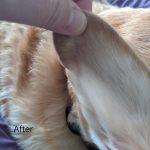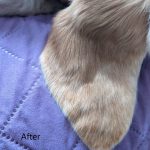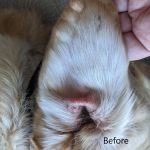Hello,
If you are under the care of a veterinarian then please forward these questions to them. It is not possible for us to answer what is it is not safe for your pet as we don’t know anything about their current health status or history. These are obtained during a physical examination with your veterinarian.
Hello Dr. Magnifico,
My golden retriever has been having a problem with hematomas on both ears for the last few months. We have tried everything short of surgery. I saw a video of you on YouTube treating a labrador with a drain. Is this very successful? Do you know of any vet close to me who does this technique. If not, I am willing to come to you. We are really at our wit’s end.
Thank you,
Lenore DeLorenzo
My cat developed a hematoma so we took her to the vet and they charged us $400 to drain it without anesthesia. After about 2 weeks it filled back up again so we took her to a different vet and they want us to spend $1,000 to have it surgically drained but with no guarantee that it won’t come back. Will it heal on its own or is it worth it to spend the $1,000 with the chance that it might come back?
Comments
Ear hematoma in dog is an affliction which gets too much attention for needing surgery to repair. In fact, surgery seems to cause more damage than the hematoma itself. First, let’s look at the cause. Something has happened to rupture a feeding artery into the pinna. An underlying condition contributing to ear irritation most likely made the dog rake the ear against something or shaking the ear repeatedly. Either way, an artery is the only blood vessel strong enough to release fluid pressure to tear apart the tissues binding the skin and cartilage. These tears as well begin releasing fluids into the now ever-growing hematoma being created. Here is where different approaches to treatment occur. Should the vet address the blood pool only and aspirate once or multiple times? Should the vet incise the ear and suture the skin back to the cartilage? Should the vet install a drain or allow fluids from the bleeding vessels to exit the ear? In my opinion Yes, No and No. Aspiration alone relieves fluid buildup without harming or wounding. If coagulation has already begun, then a hypodermic needle aspiration will be non-effective. With an early onset hematoma, a hypodermic needle aspiration is pet and pet parent friendly with both relieving the pain for the animal and keeping costs down for owner. However, aspiration is not going to fix the broken blood vessel. The only way to repair the broken blood vessel feeding the hematoma is to allow the animal time to build reparative tissues to seal the break. These repairs take place while the aural hematoma condition is in suspension, meaning the hematoma is no longer filling, the fluids become still allowing for rapid coagulation to begin growing granulation against both skin and cartilage, and the once flowing broken blood vessel now has back pressure against it and the site of break begins to seal and heal. This occurs naturally in untreated aural hematoma. Consequences are that the bulbous blood clot formed is reduced in a fashion where granulation has attached all skin and cartilage to the blood clot, and as the clot is reduced towards the center, the skin and cartilage are pulled along with it causing the shrivel. Since in this scenario the amount of shrivel is proportionate to the diameter of the blood clot, then the solution would be to limit the blood clot size to as thin a layer as possible, making the skin and cartilage in as close proximity as possible at time of blood clot coagulation and granulation. This process is not foreign to veterinary medical. Splinting the auricle for a duration of time will achieve natural healing by allowing a thin layer of blood clot to form in the entirety of the hematoma region. The thin layer acts in the same fashion as a natural bulbous clot, but without the consequences of crinkling the ear after reabsorption. Keeping an open mind to aural splinting for aural hematoma can and will bring new Holistic medical treatments needed to address the current clinical duress patients and their owners are now having to endure.
I have a 12 year old cat who developed an aural hematoma. He had surgery two days ago (Friday) to drain the ear and this evening (Sunday), it started to swell up again.
Is this to be expected? He started shaking his head as well and not sure how to prevent him from doing so.
Unfortunately it is late at night and I am not able to reach the vet. Any assistance is greatly appreciated.
I am helping someone who rescued a young female stray cat a few weeks ago. No microchip. The plan is to get her vetted and adopted. She tested positive for ear mites , & tapeworms. She has had 2 applications of Revolution , 2 weeks apart, per vet instructions. She had an ear hematoma that the vet drained and sutured. The vet gave her virbantel dewormer tablet , and she is now due for her second dose, the info with this product states it is for dogs and puppies only. She didn’t get that 2nd dose, will consult with vet about it – recheck visit tomorrow. My question is about the virbantel tablet, is it safe for use on cats? What are the risks ? She has had other symptoms that we thought were unrelated , now I am wondering if the 1st dose she received at the vet had some side effects. Also she was shaved to check for a spay scar, I attached photo. Looks like there were two incisions. Any thoughts and or advice would be greatly appreciated. Thanks!
Comments
My dog has a drain in his ear for an aural hematoma. It has been in for a week and is supposed to be in for 2 more but it appears as though it may be coming out. What happens if it comes out before we get to the vet?
Comments
My cat has hematoma is his ear. I don’t have hundreds of dollars to pay a vet. Are there any alternatives?













Hello,
I’m so sorry for the delay. I cannot imagine any kind of surgical correction of this condition that warrants a $1000 fee.
Please let me know what happened. I would be really curious about how this fee is justified. Email me at Krista@pawbly.com